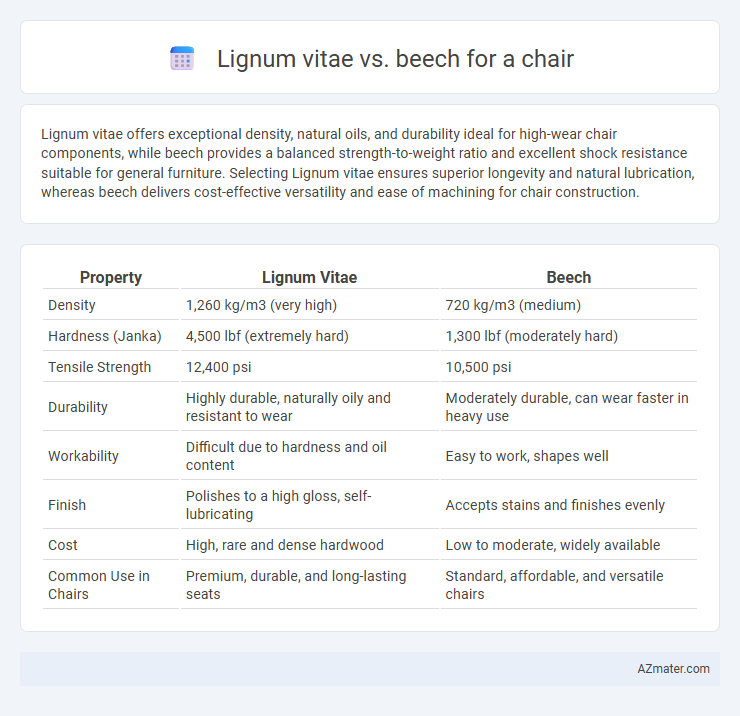Lignum vitae offers exceptional density, natural oils, and durability ideal for high-wear chair components, while beech provides a balanced strength-to-weight ratio and excellent shock resistance suitable for general furniture. Selecting Lignum vitae ensures superior longevity and natural lubrication, whereas beech delivers cost-effective versatility and ease of machining for chair construction.
Table of Comparison
| Property | Lignum Vitae | Beech |
|---|---|---|
| Density | 1,260 kg/m3 (very high) | 720 kg/m3 (medium) |
| Hardness (Janka) | 4,500 lbf (extremely hard) | 1,300 lbf (moderately hard) |
| Tensile Strength | 12,400 psi | 10,500 psi |
| Durability | Highly durable, naturally oily and resistant to wear | Moderately durable, can wear faster in heavy use |
| Workability | Difficult due to hardness and oil content | Easy to work, shapes well |
| Finish | Polishes to a high gloss, self-lubricating | Accepts stains and finishes evenly |
| Cost | High, rare and dense hardwood | Low to moderate, widely available |
| Common Use in Chairs | Premium, durable, and long-lasting seats | Standard, affordable, and versatile chairs |
Introduction to Lignum Vitae and Beech for Chair Making
Lignum vitae, known for its exceptional density and natural oils, offers superior durability and resistance to wear, making it ideal for high-quality chair making. Beech wood, prized for its fine grain and ease of machining, provides a smooth finish and moderate strength suitable for crafting comfortable, affordable chairs. Both woods serve distinct purposes in chair construction, balancing strength, workability, and aesthetic appeal.
Wood Properties: Lignum Vitae vs Beech
Lignum vitae exhibits exceptional hardness and natural oil content, providing superior durability and resistance to moisture compared to Beech, which is a moderately hard wood known for its fine grain and ease of machining. While Beech offers good shock resistance and is more readily available, Lignum vitae's high density and self-lubricating properties make it ideal for heavy-use chair components subjected to wear. The extreme hardness of Lignum vitae, rated around 4,500 lbf on the Janka scale, surpasses Beech's 1,300 lbf, resulting in longer-lasting furniture with greater resistance to dents and abrasion.
Durability and Longevity Comparison
Lignum vitae is renowned for its exceptional durability, boasting a Janka hardness of about 4,500 lbf, which makes it one of the hardest and most wear-resistant woods available, ideal for long-lasting chair construction. Beech, with a Janka hardness around 1,300 lbf, offers moderate strength and durability but is more prone to dents and wear over time compared to lignum vitae. The natural oils and dense grain of lignum vitae enhance its resistance to moisture and decay, significantly extending the lifespan of chairs made from it compared to the relatively softer, less oily beech wood.
Workability: Ease of Crafting Chairs
Lignum vitae's exceptional density and natural oils make it extremely durable but challenging to work with, requiring specialized tools and skills for crafting chairs. Beech, on the other hand, offers excellent workability due to its moderate hardness and fine, uniform grain, allowing for easier cutting, shaping, and sanding. This makes beech a preferred choice for craftsmen seeking efficiency and precision in chair making.
Aesthetic Differences: Color and Grain
Lignum vitae features a rich, dark brown to greenish hue with a fine, dense grain that imparts a luxurious and polished appearance to chairs. Beech offers a lighter, creamy beige to pinkish color with a uniform grain pattern, providing a more contemporary and clean aesthetic. The contrast between Lignum vitae's deep, complex tones and Beech's lighter, subtler shades influences the overall visual appeal and style preference in chair design.
Comfort and Ergonomics in Chair Design
Lignum vitae offers exceptional density and natural oiliness, providing a smooth, durable surface that enhances long-term seating comfort and ergonomic support. Beech, known for its fine grain and moderate hardness, is flexible enough to allow for contoured chair designs that improve posture and reduce pressure points. The combination of Lignum vitae's stability and Beech's adaptability makes them both valuable for ergonomic chair construction focused on user comfort.
Weight and Handling Factors
Lignum vitae is significantly denser and heavier than beech, with a typical density around 1,260 kg/m3 compared to beech's 720 kg/m3, impacting the overall weight of chairs made from these woods. This increased density makes Lignum vitae chairs exceptionally durable but harder to handle and move due to their substantial weight. Beech offers a lighter, more user-friendly option that facilitates easier handling and repositioning without sacrificing moderate strength and stability.
Environmental Impact and Sustainability
Lignum vitae, known for its extreme density and natural oils, offers exceptional durability and requires less frequent replacement, reducing resource consumption over time compared to beech. Beech, a fast-growing hardwood, supports sustainable forestry practices due to its rapid regrowth and widespread availability, making it a more eco-friendly option in terms of raw material supply. The environmental impact of lignum vitae is higher because of its slow growth and limited sources, whereas beech's efficient carbon sequestration and lower transportation emissions enhance its sustainability profile for chair manufacturing.
Cost Comparison and Market Availability
Lignum vitae is significantly more expensive than beech due to its density, durability, and rarity, making it a premium choice for high-end chairs. Beech offers a cost-effective alternative with widespread availability, commonly found in furniture markets and woodworking suppliers worldwide. Market availability of lignum vitae is limited, often sourced from specialized timber dealers, whereas beech is abundant and easily accessible for mass production.
Final Verdict: Best Choice for Chairs
Lignum vitae offers superior hardness, natural oil content for durability, and resistance to wear, making it ideal for long-lasting, heavy-use chairs. Beech wood provides excellent workability, uniform grain, and affordability, suitable for affordable and elegantly designed chairs. For a balance of strength and endurance in high-traffic areas, Lignum vitae is the best choice, while Beech suits budget-conscious, decorative furniture.

Infographic: Lignum vitae vs Beech for Chair
 azmater.com
azmater.com